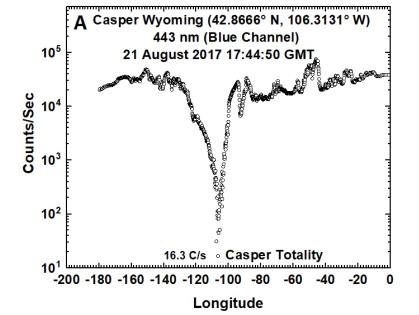The effect of an eclipse on the solar energy reaching the earth’s surface. In Casper WY, the eclipse reached almost zero energy reflected back to space.
The effect of an eclipse on the solar energy reaching the earth’s surface. In Columbia, MO, light clouds diminished the effect.
A west to east slice through totality for Casper, WY and Columbia, MO
Counts/second C/S observed by EPIC for the 443 nm channel corresponding to the color image for Casper, WY
The EPIC instrument onboard the DSCOVR spacecraft, located near the Earth-Sun Lagrange-1 point, is able to observe the shadow from the lunar eclipse of the sun (21 August 2017) as is crossed the United States from west to east. When the shadow was over Casper, Wyoming at 17:44:50 UTC, the reflected irradiance was almost zero in the narrow region of totality. Outside of this region, EPIC observed the partial eclipse shadow and the fully illuminated regions of the Earth’s disk. The integrated reflected irradiance from the Earth decreased by about 10% compared to the average irradiances measured on the days before and after the eclipse for approximately the same observing geometry as occurred during the eclipse.


Eclipse Causes a 10% reduction in Reflected Light from the Earth
Details are in an article (Herman et al., 2018 in AMT (in Review))
The appearance of the earth during the eclipse at six selected wavelegths. The effect of Rayleigh scattering is shown in the UV channels. The clearest view of the land surfaces in in the near IR 780 nm channel. Note: North is down
Log plot showing the light reduction that occurred during the eclipse over Casper, WY. The light reduction ratio was 935

Synoptic view of the sunlit Earth perturbed by the 21 August 2017 total eclipse centered over Casper, Wyoming at 17:44:50 UTC. and over Columbia, Missouri at 18:14:50 UTC










